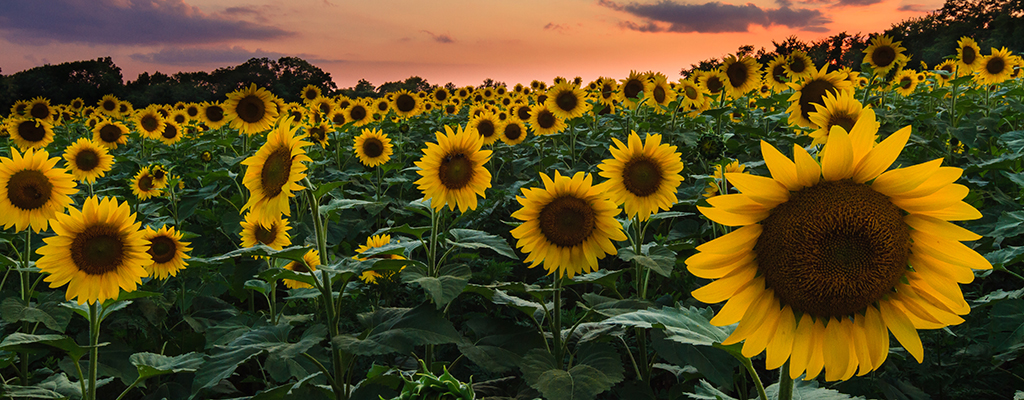Behind the Beauty: Sunflower fields impress and nourish

McKee Beshers; by Mohib Ahmad
In Greek mythology, a nymph emerged from the sea to dance on the shore. Catching a glimpse of Apollo in his golden chariot, she became infatuated and returned every morning to see him break day. The sun god smiled upon her, until his interests turned elsewhere. She sat on a rock for nine days, watching and hoping for his favor. Pitied by the other gods, they transformed her into a flower that followed the path of the sun.
We too chase the sun, and many of us, its namesake flower. It evokes joy and friendship and entrances us in the fading summer light. A popular family activity and many a photographer’s dream backdrop, we flock to the endless fields of helio-worshipping plants to bask in and capture their beauty. But it’s not all about looks.
 |
|
Wildlife Management Areas with Sunflower Fields: |
Another purpose
The Maryland Department of Natural Resources oversees the management of 61 wildlife management areas—encompassing approximately 123,000 acres across the state—with the goal of enhancing, maintaining and protecting diverse and sustainable wildlife populations as well as their habitats.
With an emphasis on hunting, these areas provide both wildlife-dependent recreation and venues in which to educate citizens on the value and needs of wildlife and plant communities through demonstration, outreach and sound management.
Sunflowers are commonly planted in areas that include agricultural land. Most years, the department plants about 130 acres of sunflowers on 15 wildlife management areas spanning 18 of Maryland’s counties. The primary purpose is to provide a source of seed that attracts mourning doves, as well as other wildlife species, after the plants mature and dry. Mourning doves are hunted at and near these fields during seasons that traditionally begin in early September and continue through early January.
Sunflower seeds are a favorite food for a host of other birds including cardinals, chickadees, blue jays and finches. Sunflowers require pollination by insects, usually bees, to produce a seed crop. In turn, they benefit from the abundant nectar and pollen that sunflowers produce.
A word of caution
The many benefits of sunflowers are lost when they are cut or trampled by people. These sunflowers are planted for the sake of wildlife. Wildlife management areas are open to the public, however, visitors must be responsible and ensure that their actions don’t have negative consequences.
While some privately owned sunflower fields are purely tourist attractions, regulations at wildlife management areas prohibit the cutting, destruction or removal of any plants.
So just remember, while we mere mortals continue to admire the full bloom aesthetics, keep in mind that other beings depend on them for nourishment after the sun’s favor passes.
 Mourning dove; by Thomas Bancroft Mourning doves Mourning doves can be identified by their plump, grayish brown bodies, small heads and long pointed tails. They can reach speeds of 37-55 miles per hour in the air. Males are easily distinguished from females by an iridescent blue patch of feathers on the backs of their heads, making them slightly more colorful. They are named for their hollow, sorrowful sounding call, which is often mistaken for the hoot of an owl. Mourning doves are abundant in Maryland due to their ability to adapt to a variety of habitats and their high reproductive rate. Although a pair only rears two eggs at a time, it is not unusual for them to have four to six clutches in a year. Good parents, males and females work together to raise their young; they may even fake an injury to attract predators away from nests. It is estimated that nearly 400,000 mourning doves live in Maryland March-November. A greater number can be seen in August, as they pass through en route to the Carolinas. Mourning doves typically feed on flat surfaces on the ground, consuming an average of 12-20 percent of their body weight per day in seeds. They are common visitors to bird feeders, often feasting off the seeds that spill to the ground. Among their favorites are millet and, of course, sunflower seed. |
| Dove Management Areas are funded with Federal Aid in Wildlife Restoration Funds and revenue generated from hunting licenses–commonly known as Pittman-Robertson Act funds–which come from a federal excise tax on sporting arms, ammunition, archery equipment and handguns.
These funds are collected from the manufacturers and distributed each year to states and territorial areas by the U.S. Department of the Interior. Each state’s proportion is based on the area of the state and the number of licensed hunters there. Non-hunting nature lovers equally benefit from this funding since it supports the management of wildlife areas and wetlands, as well as game and non-game wildlife. |
Article by Nancy Doran—Wildlife and Heritage Service information and education manager. Appears in Vol. 21, No. 3 of the Maryland Natural Resource magazine, summer 2018.

